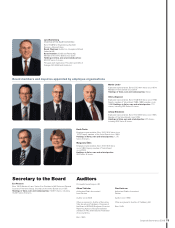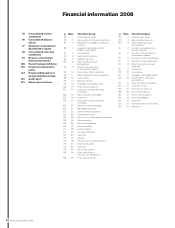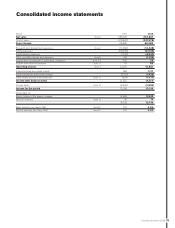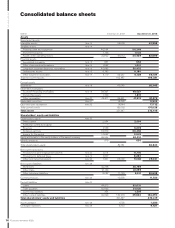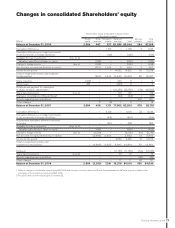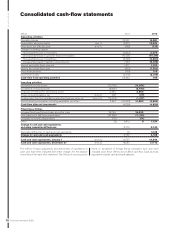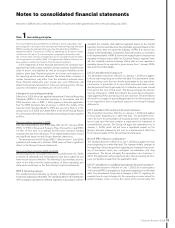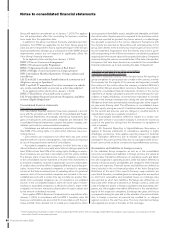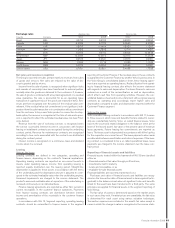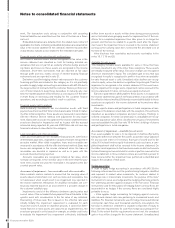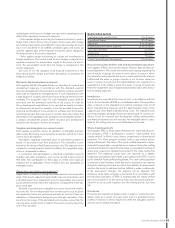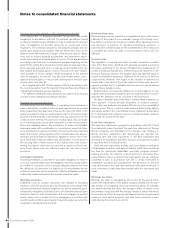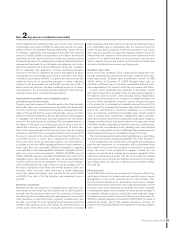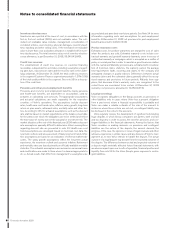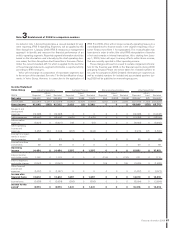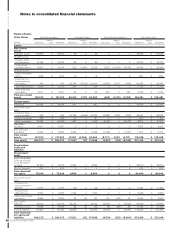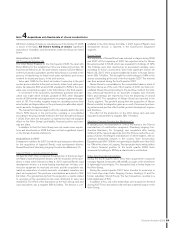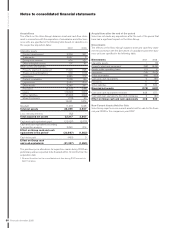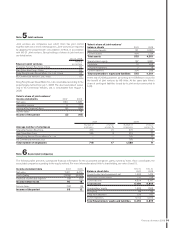Volvo 2008 Annual Report Download - page 87
Download and view the complete annual report
Please find page 87 of the 2008 Volvo annual report below. You can navigate through the pages in the report by either clicking on the pages listed below, or by using the keyword search tool below to find specific information within the annual report.
83
Financial information 2008
realized gains and losses on hedges are reported in operating income
within Other operating income and expenses.
– Volvo applies hedge accounting for fi nancial instruments used to
hedge interest and currency risks on loans only for cases when hedge
accounting requirements are fulfi lled. For cases where hedge account-
ing is not considered to be fulfi lled, unrealized gains and losses up
until the maturity date of the fi nancial instrument will be charged to
the fi nancial net in the income statement.
– Volvo applies hedge accounting for certain net investments in
foreign operations. The current result for such hedges is reported in a
separate component in shareholders’ equity. In the event of a divest-
ment, the accumulated result from the hedge is recognized in the
income statement.
See note 37 for the valuation of all fi nancial instruments in the
Volvo Group and for details and further description on principles for
hedge accounting.
Research and development expenses
Volvo applies IAS 38, Intangible Assets, for reporting of research and
development expenses. In accordance with this standard, expend-
itures for development of new products, production systems and soft-
ware shall be reported as intangible assets if such expenditures with
a high degree of certainty will result in future fi nancial benefi ts for the
company. The acquisition value for such intangible assets shall be
amortized over the estimated useful life of the assets. In order for
these development expenditures to be reported as assets, a number
of criteria must be met. For example, it must be possible to prove the
technical functionality of a new product or software prior to its devel-
opment being reported as an asset. In normal cases, this means that
expenditures are capitalized only during the industrialization phase of
a product development project. Other research and development
expenses are charged to income as incurred.
Tangible and intangible non-current assets
Volvo applies acquisition values for valuation of intangible and tan-
gible assets. Borrowing costs during the acquisition period for a non-
current asset are expense.
Information regarding estimated value of investment property is
based on discounted cash fl ow projections. The estimation is per-
formed by the Group’s Real Estate business unit. The required return
is based on current property market conditions for comparable prop-
erties in comparable locations.
In connection with participation in industrial cooperation projects
together with other companies, such as the aircraft engine projects
that Volvo Aero participates in, Volvo pays in certain cases pays an
entrance fee to participate. These entrance fees are capitalized as
intangible assets.
Depreciation, amortization and impairment
Depreciation is made on a straight-line basis based on the acquisition
value of the assets, adjusted in appropriate cases by write-downs, and
estimated useful lives. Impairment tests for depreciable non-current
assets are performed if there are indications of impairment at the bal-
ance sheet date.
Goodwill is reported as an intangible non-current asset with indefi n-
ite useful life. For non-depreciable non-current assets such as good-
will, impairment tests are performed annually, as well as if there are
indications of impairments during the year, through calculation of the
asset’s recovery value. If the calculated recovery value is less than the
carrying value, a write-down is made to the asset’s recovery value. See
note 14 for goodwill.
Depreciation periods
Capitalized type-specifi c tools 2 to 8 years
Operational leases 3 to 5 years
Machinery 5 to 20 years
Buildings and Investment property 25 to 50 years
Land improvements 20 years
Trademarks 20 years
Distribution networks 10 years
Product and software development 3 to 8 years
Non-current assets held for sale and discontinued operations
Volvo applies IFRS 5, Non-current Assets Held for Sale and Discon-
tinued Operations. Processes are continuously ongoing regarding the
sale of assets or groups of assets at minor values. In cases in which
the criteria for being classifi ed as a non-current asset held for sale are
fulfi lled and the asset or group of assets is not of minor value, the
asset or group of assets and the related liabilities are reported on a
separate line in the balance sheet. The asset or group of assets are
tested for impairment and, if impaired valued at fair value after deduc-
tion for selling expenses.
Inventories
Inventories are reported at the lower of cost, in accordance with the
fi rst-in, fi rst-out method (FIFO), or net realizable value. The acquisition
value is based on the standard cost method, including costs for all
direct manufacturing expenses and the apportionable share of the
capacity and other related manufacturing costs. The standard costs
are tested regularly and adjustments are made based on current con-
ditions. Costs for research and development, selling, administration
and fi nancial expenses are not included. Net realizable value is calcu-
lated as the selling price less costs attributable to the sale.
Share-based payments
Volvo applies IFRS 2, Share-based Payments for share-based incen-
tive programs. IFRS 2 distinguishes between “cash-settled” and
“equity-settled”, in Volvo’s case, shares, components of share-based
payments. The Volvo program includes both a cash-settled and an
equity-settled part. The value of the equity-settled payments is deter-
mined at the grant-date, recognized as an expense during the vesting
period and credited to equity. The fair value is calculated according to
share price reduced by dividend connected to the share before the
allotment. The additional social costs are reported as a liability,
revalued at each balance sheet date in accordance with UFR 7, issued
by the Swedish Financial Reporting Board. The cash-settled payment
is revalued at each balance sheet day and is reported as an expense
during the vesting period and as a short term liability. An assessment
whether the terms for allotment will be fulfi lled is made continuously.
If the assessment changes, the expense will be adjusted. The
employee stock option program is accounted for in accordance with
the transition principles of IFRS 2, meaning that the equity-settled
part is accounted for at fair value at each reporting period and pro-
vided for as an accrued expense over the vesting period. See note
34.
Provisions
Provisions are reported on balance when a legal or constructive obli-
gation exists as a result of a past event and it is probable that an
outfl ow of resources will be required to settle the obligation and the
amount can be reliably estimated.


